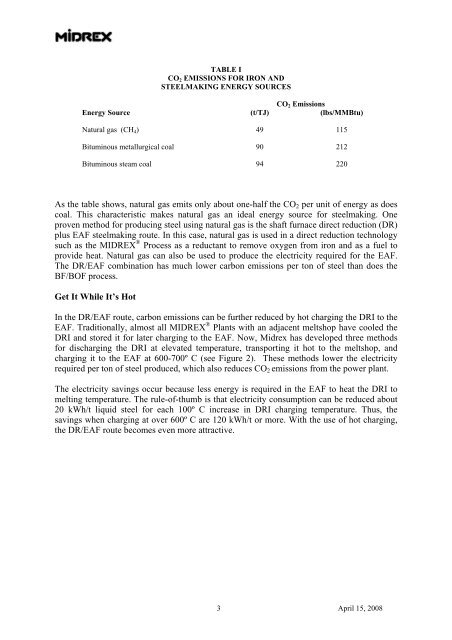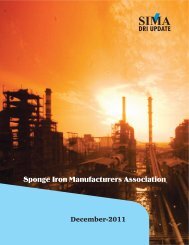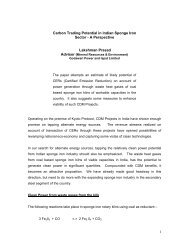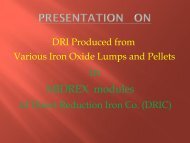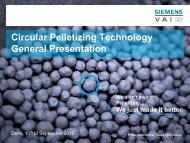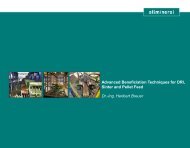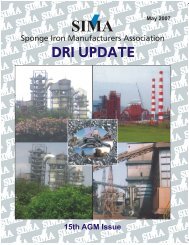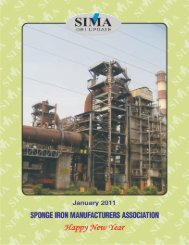Green Steelmaking with the MIDREX and FASTMET Processes
Green Steelmaking with the MIDREX and FASTMET Processes
Green Steelmaking with the MIDREX and FASTMET Processes
Create successful ePaper yourself
Turn your PDF publications into a flip-book with our unique Google optimized e-Paper software.
TABLE I<br />
CO 2 EMISSIONS FOR IRON AND<br />
STEELMAKING ENERGY SOURCES<br />
CO 2 Emissions<br />
Energy Source (t/TJ) (lbs/MMBtu)<br />
Natural gas (CH 4 ) 49 115<br />
Bituminous metallurgical coal 90 212<br />
Bituminous steam coal 94 220<br />
As <strong>the</strong> table shows, natural gas emits only about one-half <strong>the</strong> CO 2 per unit of energy as does<br />
coal. This characteristic makes natural gas an ideal energy source for steelmaking. One<br />
proven method for producing steel using natural gas is <strong>the</strong> shaft furnace direct reduction (DR)<br />
plus EAF steelmaking route. In this case, natural gas is used in a direct reduction technology<br />
such as <strong>the</strong> <strong>MIDREX</strong> ® Process as a reductant to remove oxygen from iron <strong>and</strong> as a fuel to<br />
provide heat. Natural gas can also be used to produce <strong>the</strong> electricity required for <strong>the</strong> EAF.<br />
The DR/EAF combination has much lower carbon emissions per ton of steel than does <strong>the</strong><br />
BF/BOF process.<br />
Get It While It’s Hot<br />
In <strong>the</strong> DR/EAF route, carbon emissions can be fur<strong>the</strong>r reduced by hot charging <strong>the</strong> DRI to <strong>the</strong><br />
EAF. Traditionally, almost all <strong>MIDREX</strong> ® Plants <strong>with</strong> an adjacent meltshop have cooled <strong>the</strong><br />
DRI <strong>and</strong> stored it for later charging to <strong>the</strong> EAF. Now, Midrex has developed three methods<br />
for discharging <strong>the</strong> DRI at elevated temperature, transporting it hot to <strong>the</strong> meltshop, <strong>and</strong><br />
charging it to <strong>the</strong> EAF at 600-700º C (see Figure 2). These methods lower <strong>the</strong> electricity<br />
required per ton of steel produced, which also reduces CO 2 emissions from <strong>the</strong> power plant.<br />
The electricity savings occur because less energy is required in <strong>the</strong> EAF to heat <strong>the</strong> DRI to<br />
melting temperature. The rule-of-thumb is that electricity consumption can be reduced about<br />
20 kWh/t liquid steel for each 100º C increase in DRI charging temperature. Thus, <strong>the</strong><br />
savings when charging at over 600º C are 120 kWh/t or more. With <strong>the</strong> use of hot charging,<br />
<strong>the</strong> DR/EAF route becomes even more attractive.<br />
3 April 15, 2008


